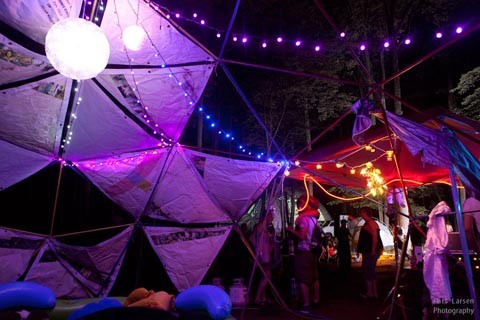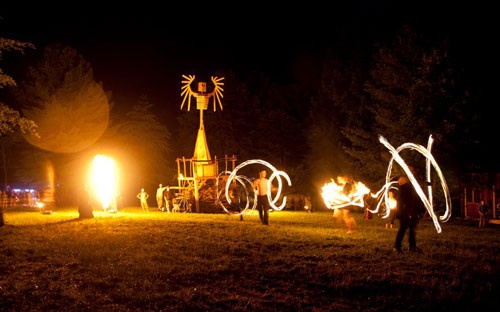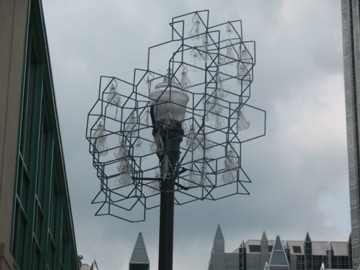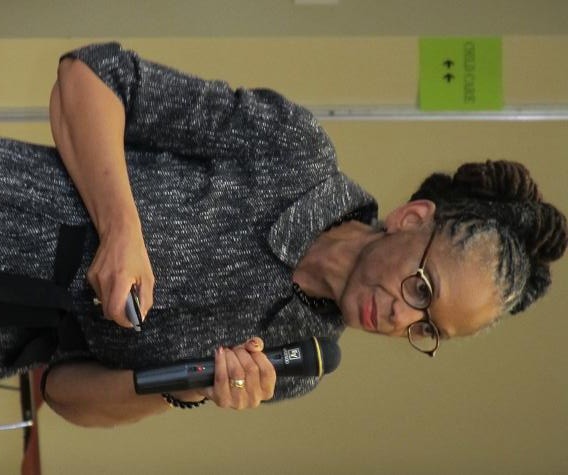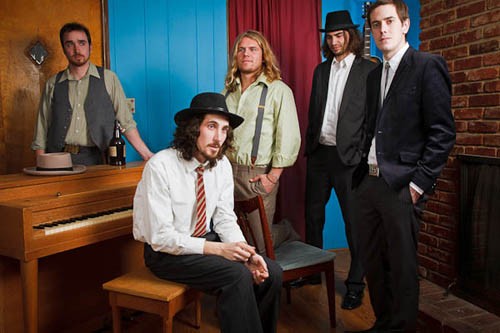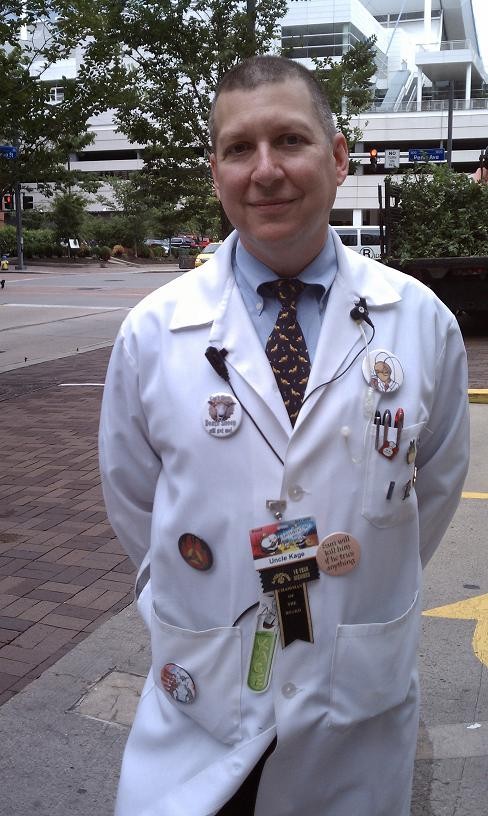Thursday, June 30, 2011
First, a programming note: As you may have noticed recently, we've got more City Paper staffers contributing to the pile here at Slag Heap these days. What began as essentially an opinion-with-occasional-news blog, written almost entirely by me, is morphing into a news-with-occasional-opinions blog, with contributions from various folks.
Accordingly, I'll be flagging posts -- like this one -- that offer a more opinion-driven take on current events.
On to the business at hand. Tomorrow begins the new format at WDUQ, the jazz-and-NPR station long operated by Duquesne University. Starting July 1, the station will shift to a news-driven format run cooperatively by local station WYEP and Public Media Company, a new nonprofit affiliated with a Colorado public-radio enterprise. (CORRECTION: The entity running the station, Essential Public Media, is wholly owned by WYEP. While the local station has been acting in partnership with Public Media Company, WYEP General Manager Lee Ferraro stresses that PMC, which helped facilitate the acquisition, has no input on programming decisions or other operations.) And some bruised feelings are in evidence.
Read, for example, Charlie Humphrey's take on the transition here. Humphrey has been actively involved in this transition, and I think it's safe to say he's grown weary of hearing from jazz fans outraged at losing their platform. To wit:
A recent letter to the editor in the Post-Gazette about the sale of WDUQ states that "jazz [is] inarguably the most influential cultural innovation of the 20th century." Hum. Inarguably. Well, that pretty much ends the conversation.
But I'll argue it anyway. I think the crown of cultural innovation should go to the civil rights movement, or rock and roll, or penicillin or Pee Wee Herman. What about Prince, or the Hula Hoop? What about Shirley Temple, or the Wizard of Oz? What about Elvis? I think we need an all-Elvis radio station here, and I also think it is my God-given right to have one. Porky Chedwick, where are you?
Humphrey also asserts that "Jazz radio in Western Pennsylvania is unsustainable." The proof being that: a) WDUQ's ratings drop when NPR stops and jazz starts; b) Pittsburgh doesn't sustain a lot of jazz clubs; and c) Duquesne University had to subsidize WDUQ's operations. "How can jazz listeners actually believe they are entitled to that level of subsidy from a private university?" he asks.
I'm not sure Humphrey really wants to go there. First off, NPR isn't self-sustaining either -- it receives government subsidies. And as a look at recent headlines suggests, plenty of people don't think NPR's audience should feel "entitled" to that money either.
In any case, Humphrey invites the rejoinder that his own organization, Pittsburgh Filmmakers, isn't sustainable either, since its operations depend on institutional support as well. To be honest, I'm not sure how fair that comparison is; the operative part of Humphrey's question is "from a private university." But once you start likening a decades-old musical heritage to the hula hoop, you really can't complain about the other side's unfair analogies.
A less argumentative take on the issue is provided by Katherine Fink, a former WDUQ staffer who has since moved on to grad school at Columbia, no less. Fink worked on WDUQ's news side; in fact, I suspect she'd fit in well at the station Humphrey hopes to have on the new 90.5. Even so, she expresses some misgivings about the change:
As a former news reporter and anchor at the station, it might surprise you that I’m against the loss of jazz programming at WDUQ. After all, the amount of local news content will apparently increase, according to Essential Public Media, the new owner. I appreciate that the station will have a local interview/call-in show, and a weekly program dedicated to local public affairs issues ... But it remains to be seen whether the changes EPM will bring will result in better community service.
Fink goes on to take issue with some of the claims being made by proponents of the new format. But the more interesting part of her argument is philosophical:
Some proponents of the new WDUQ have also argued that it makes sense to get rid of jazz because it has a smaller audience. Whether noncommercial broadcasting should try to appeal to mass audiences is a debate that’s older than the U.S. public broadcasting system itself. Personally, I side with the original Carnegie Commission, whose recommendations formed the basis of the Public Broadcasting Act of 1967. The Commission believed that public broadcasting should promote diversity--that it should serve many niche audiences, the ones that commercial broadcasters tend to ignore. Bill Siemering, one of NPR’s founders, wrote in the organization’s original mission statement that public radio should "speak with many voices” and “celebrate the human experience as infinitely varied." It’s in that spirit that many public radio stations adopted “checkerboard” formats -- like news/jazz, or news/classical, with all kinds of other shows on weekends -- to serve multiple smaller audiences with varied interests.
The checkerboard format is on its way out; WDUQ’s is just the latest example.
For me, this gets at exactly what I think is at stake with the new station ... and why I'm not losing too much sleep over the old one.
For my tastes, the problem with WDUQ is that it wasn't enough of a checkerboard. Even too much of the jazz sounded the same: You weren't likely to tune in and hear John Zorn or Sun Ra, for example, at 90.5. WDUQ did have some musical programming that wasn't mainstream jazz: For example, it sported a weekly Indian music broadcast (which will be included on the new station). But I'd be much more upset by WDUQ's disappearance, I think, if it'd served a whole bunch of different niches, as opposed to just a few.
That said, Fink's post points up with the part of Humphrey's argument that gives me pause. That would be the part where he cites WDUQ's Arbitron ratings as evidence for the wisdom of a new format:
According to January 2010 Arbitron ratings (Arbitron is the company most used to monitor radio usage), WDUQ was ranked No. 5 among all local radio stations in the market during morning drive time, when NPR's Morning Edition is aired. During morning drive time, 90.5 is right up there with behemoths like WDVE and KDKA.
Now, what is WDUQ's ranking at 10 a.m., when jazz is in full swing? No. 15. You can practically hear radio receivers being turned off around Western Pennsylvania when jazz follows news and information.
Well, shit. If that's your standard, maybe the new WDUQ should adopt the BOB-FM format: Mixing Def Leppard and Sheryl Crow into the same playlist has done wonders for 96.9, which is owned by my corporate overlords here at Steel City Media.
Yes, yes: Public radio should serve a broad swath of the public. But it can be a fine line between that and the market-driven logic that produces so much of the dreck on the rest of the radio dial.
And let's face it: While we all love This American Life and Morning Edition, it's a little harder to make the case that airing, say, Car Talk or The Splendid Table is a sacred trust. Looking over the shows currently on the Essential Public Media program schedule, I can see several I'd happily jettison in favor of, say, Democracy Now.
Yeah, I'm an unrepentent lefty. So it's no surprise I'd prefer Amy Goodman to Lynn Rossetto Kasper. But if you believe, as Fink does, that public radio should try to serve a variety of niches, then it's sad to learn I'm only a little better off with EPM's latte-liberal programming than I was with WDUQ.
Of course, the new 90.5 doesn't even exist yet. I mean, the FCC hasn't yet actually approved the transfer of WDUQ's license to the new owners. It's way too soon to judge its effectiveness.
Like Humphrey, I guess, I find it tiresome that the jazz-versus-not-jazz argument has sucked up all the oxygen in this debate. What's more, I've worked on projects with Humphrey before, and know him to be a bright, sincere guy. Hell, City Paper is a media partner with the PublicSource media initiative he's launching along with the new station. (More about that sometime soon.) It's true that the programming schedule is real light on local offerings -- most of what's there was already running on either WDUQ or WYEP. But that will change -- in large part because of PublicSource, which Humphrey is pledging will help deliver aggressive, long-form journalism.
Let's hope so. As Fink herself graciously concludes her blog post:
I know there’s a lot of room for improvement at WDUQ. Despite my misgivings, I do wish EPM success. But please, let’s not define success in terms of how well the new WDUQ mimics the formats of other big-city NPR news stations, or how large its audience is.
Exactly.
Tags: Slag Heap
Wednesday, June 29, 2011
The regional Wickerman Burn took place at Four Quarters, a rural Middle Earth-esque wonderland in Artemas, Pa. near the Pennsylvania/Maryland border, and happened this month from June 13th to the 20th. Over the course of seven days, the campground was transformed from an area speckled with semi-permanent campsites to a fleshed-out town full of art and music. All of the labor – planning, organizing, building – was done out of love, and while that sounds like a pie-in-they-sky hippie conceit, it actually worked.
The provisional town included a free clothing store, free coffee shop, and a bar where the homebrews cost nothing more than an exchange of words with the barkeep. There were crafts for kids, a sweat lodge for cleansing, and non-stop music.
Wickerman kept sonic strokes of the traditional with hand drum circles at the top of Four Quarters but wander down the hill to Sound Town and you entered a 24-hour party-zone. Three camps had sophisticated sound systems and no shortage of both amateur and professional DJs who spun freewheeling sets brimming with track choices that ranged from lazy daytime jazz to heady dubstep to psy-trance.
Poi fire spinners roamed the campgrounds with their arsenal of flaming toys. Led by one of the Wickerman organizers, Aerial Alexander, a team of poi performers flanked the Wickerman structure during the ceremonial burn that happened on Saturday night. Their acrobatics were impressive enough in the daylight as they spun hula-hoops and balls on chains, when the sun went down and fire was incorporated into their dance, their act become Cirque de Soleil stunts turned tribal. They ate fire and beat matched their spinning to the hand drummers and the DJ's, painting the air around them with curvilinear flame designs.
Luminescent art took a pixilated form as the Levitation Theory multimedia production and performance crew set up a large dome and had some six odd projectors to incorporate live visuals with the DJ sets. On the last night the crew moved their visual equipment to project onto the trees turning the forest into a magical boundless club-space, dance floor slightly muddy from the incessant rainfall but still peppered with die-hard Wickerman attendees who held on 'til the concluding hours.
The final day of the fest required the last gasp of teamwork for a tired crew of festival-goers and true to their ideals they left nothing behind. Muddy, exhausted and bug bitten everyone packed up the miraculously unscathed sound equipment, deconstructed tents and gathered any and all garbage. Every aspect of the festival, whether it was turning a vehicle into a work of art, cooking a meal, building shelter or throwing a dance party, was done by sheer teamwork. Ultimately, Wickerman was a celebration of the collective's ability to turn any creative idea into a reality and it was a beautiful experience.
Tags: Fire Spinning , Wickerman Burn , Pennsylvania , FFW>> , Image
Although they're steps away from each other, I had always had the feeling that the Cultural District and Market Square were somehow very separate; it might have something to do with the triangular layout of Downtown's streets and avenues, which anyone not from around here probably thinks is pretty weird.
Apparently, the Pittsburgh Downtown Partnership also doesn't think the connection is obvious enough, because it commissioned a new piece of public art by Carin Mincemoyer to draw traffic between the two areas.
In Pittsburgh's early days, Market Square was called the Diamond, because on a north-oriented map the square did in fact look more like a diamond. Back then Forbes Avenue was even called Diamond Street.
With this in mind, Mincemoyer (pictured) picked the diamond shape as the motif of her new piece, titled "Diamonds, Diamonds." Mounted on two light posts on Market Street, between Fifth and the Square, each identical work has a superstructure of steel rods (Pittsburgh will never relinquish steel as its material of choice), which at first glance looks like it's there only to support the illuminated diamonds hanging from the intersections.
In fact, the rods represent the molecular structure of diamonds, a crystalline expression of carbon after intense heat and pressure. The diamonds hanging within the structure are laser-cut acrylic, each lit with an LED day and night.
Market Square seems pretty excited with these new sculptures. On Tuesday, in the short time I stopped over to ogle the art as it was being installed, I saw cameras and cell phones coming out from all directions to capture the occasion. Prantl's Bakery, which sits below one of the sculptures, went so far as to sell special diamond-shaped cookies; Tuesday morning, Mincemoyer was gifting a few of these cookies to the crew of burly city workers who brought out their cherry-picker to install the sculptures.
The Office of Public Art, which along with the City made the installation possible, will host an Artist Lecture and Reception on Thu., July 14, from 6 to 8 p.m. The event is public and free, but it is politely requested you make a reservation with ProArts Tickets.
Tags: Program Notes , Image
Tuesday, June 28, 2011
The anti-gay bullying "It Gets Better" Project has attracted the help of some big names: Lady Gaga, President Barack Obama even Pittsburgh mayor Luke Ravenstahl.
Could the Pittsburgh Pirates be next?
Local LGBT activists hope so, and one of them, Sue Kerr, has started an online petition directed to the ball club's president, Frank Coonelly, chairman Bob Nutting and manager of diversity initiatives, Chaz Kellem.
The letter cites other Major League teams that have participated in Dan Savage's project: the Chicago Cubs and the San Francisco Giants.
"When I saw the Giants video, I was very moved," Kerr, author of Pittsburgh Lesbian Correspondents, tells CP in an email. "I want the Pirates to be among the leaders of this movement because it will send a strong, positive message about Pittsburgh as [a] city that values all sports fans, including LGBTQ youth. It is important that LGBTQ youth experiences with bullying be heard and validated. It is equally important to know that they have many people in their corner."
The letter reiterates that message: "It is not controversial to stand up for all youth to grow up in an environment that is safe. Doing so can send a powerful message to the young fans of the Pirates," one section of it reads.
Judging by the Nutting family's political activity, Kerr's initiative might not seem to have much of a chance. Ogden Nutting, Bob Nutting's father, has contributed nearly $12,000 to conservatives nationwide, like Michele Bachmann and Pat Toomey. Bob Nutting has also donated $1,000 to conservative West Virginia congressman David McKinley.
But team spokesman Jim Trdinich says that participating in the video project is "something we are looking to take part in, [although] the organization is still working on the most effective plan to assist everybody involved."
Kerr says the Pirates have been "receptive to the idea." As she notes on her blog, the team has held a Pride Night at PNC Park since 2004.
Kerr's effort is also being supported by groups like like Equality PA, which made a similar pitch to Pirates and Phillies fans for the effort in its weekly newsletter, and on Twitter, two weeks ago. Ted Martin, executive director of Equality PA, says there's cause for optimism in both cities: The Phillies, he points out, have annually hosted a "Gay Day Games" event for almost a decade.
"Pennsylvania has two teams that have exhibited great friendliness to the LGBT community, so they should just take this important step," Martin says in an email. "I feel good that something will happen in each place."
Tags: Slag Heap
Small class sizes might be good for students and teachers, but they're bad for a school district struggling to solve a multimillion-dollar deficit. And if the Pittsburgh Public Schools is going to balance its budget, administrators say, all the district's classrooms must be filled to capacity.
During a community presentation last night, city school officials explained that empty classroom seats represent a huge financial burden for the district, which faces a projected $68 million deficit for its next fiscal year. The meeting, hosted by A+ Schools, featured presentations from Superintendent Linda Lane and Jeanine French, both of whom stressed that reducing under-enrolled classes could save the district up to $32 million per year.
Right now, "We're running inefficiently," French, chief of school performance, told an audience of roughly 200 parents, teachers and community members inside the Pittsburgh Federation of Teachers headquarters, on the South Side.
Last night's presentation was the second community meeting focused on how the district can solve its budget deficit, which could potentially climb to $100 million by 2015 if nothing is done. In May, Lane told community members that the district's financial woes would require a number of painful changes, including central office layoffs, school closings and course reductions.
The district took its first step toward tackling the deficit last week. In a move that is expected to save an estimated $11.5 million annually, the school board voted to eliminate 217 central office positions at its June 22 legislative meeting. But with tens of millions more to cut, the district must now look to its classrooms for relief.
According to the Pittsburgh Public Schools, 60 percent of the district's classrooms currently have a "significant number" of empty seats. Just 55 percent of students are in a full class.
The district's maximum class size varies by grade: for elementary schools, it's 25 students; for middle schools, it's 28; and for high schools, it's 30. But in both elementary and middle schools, the district's current average class size is just 22 students, while the high school average is 21.
Many classrooms holding even fewer students; the situation is worst at the high school level, where there are classes with less than 15 students in some schools.
"We do have some very small classes at the high schools," Lane said.
Historically, parents and teachers often cry foul when districts propose increasing class sizes, but French stressed at the meeting that larger class sizes don't necessarily translate to poorer student achievement. The district currently has high-performing schools with large class sizes, she said, and it also has low-performing schools with small class sizes.
Whether or not that explanation will placate parents and teachers has yet to be seen. But if the district is going "to get to a place where we're spending within our means," as Lane said last night, its going to have to start putting asses in the open seats.
Monday, June 27, 2011
A brisk evening in the middle of summer is refreshing -- especially when escaping the stuffy heat of a packed rock concert. 222 Ormsby, the DIY performance space in Mt. Oliver, hosted over one hundred and fifty folks for a fine show last Friday. It was the tour kickoff and album release for White Wives --a local supergroup of sorts featuring members of Dandelion Snow, American Armada, and Anti-Flag, but thanks to the City Paper cover article, you already knew that.
Arriving at the inconspicuous venue around 7 p.m., I spotted some clean-cut kids donning t-shirts, tight shorts, and nice haircuts. Predicting a more punk-like vibe (as opposed to the cast of "Skins" outside texting on their iPhones), I shuddered at the possibility of being the oldest person in attendance. Luckily for my sake that was far from true, as there wasn't one specific "scene" present at this show, or one specific age group. Anchors End was up first, and they started the night with a fist-pumping half hour of old-fashioned Lionshead-chugging punk. The crowd cheered.
Allies' energetic, sweat-soaked set was next. The double SG guitar-attack tactically piled overtop moving bass lines and unbroken drumming to achieve this mountain of random rhythms. They burst through eight songs--many of which resembled a marriage between the sounds of older Q and Not U and Mission of Burma. The vocals on "Planet of Sums" and "Grey Capital" were better than ever, and the brand-new songs (expect a new album later this summer--their first since 2008) sounded equally great. They were the evening's definite highlight.
Balance and Composure … it sounds more akin to a self-help seminar than a young, five-piece alternative punk band. Picture a darker Jimmy Eat World or mewithoutyou with more intensity…intensity that sparked the only little mosh pit of the night (this was more of a 'watch and nod your head' sort of crowd). The lead singer's occasional pop-punky scream unbalanced my own mind's composure a bit, but within a song or two I was hooked. A few devotees traveled specifically to catch this eastern-PA band…I don't blame them.
After slamming a cold beer outside I returned to a surprise: a music video set! Blinding lights and professional cameras scattered about the Ormsby space, because graffitied walls and a packed crowd scream "music video opportunity" for most bands--including White Wives. Adding additional instrumentation (everything from keyboards to trumpets to marching percussion), White Wives ended the evening by highlighting material from their new album. The cadence-like intro to "Spinning Wheels" or the joyful "Sky Started Crying" kept the temporary Ormsby residents singing. Soon enough my exit from the 222 Ormsby's sauna was greeted by pouring rain and a sea of wet, smiling faces. How could anyone not smile after all that?
I left Mt. Oliver with three things circulating through my mind: the Balance and Composure song "Kaleidoscope" (my brain has it on repeat as I write); the urge to catch another Allies set much sooner than later; and the reminder that the best shows often take place in the least conspicuous places.
Tags: White Wives , 222 Ormsby , Mt. Oliver , FFW>>
Tags: Dead Kings , Chet Vincent , The big bend , FFW>> , Image
Sunday, June 26, 2011
Raves are typically lauded as an underground never-neverland. Teenagers, twentysomethings, and the thirysomething set of lost boys and girls come together in the name of electronic dance music. The sounds have changed since the birth of the word 'rave,' but the core concept has remained the same – dancing to rhythms around a proverbial fire.
At its core, a rave is a primal celebration. The minutiae of what exactly goes on when so many young people get together could be argued or fraught over, but in the grand scheme of things it’s a bunch of people dancing, what’s the harm?
The Summer of Love party that happened on June 11 at the Irish Center attracted a mass of hundreds, a vibrant crowd of candy kids, shirtless bros, ravers of yore and scantily clad girls. The fashions of shredded neon-tees over hip-hugging short shorts, bikini tops, and boys who sported nothing more than tattooed pecs would be debauched anywhere else but inside the balmy makeshift club space wearing little to nothing was an act of comfort if not survival.
The rooms for Summer of Love showcased two wildly different sounds. The large main room, complete with lasers, a proper stage, a wide-open dance floor and a place to purchase overpriced water bottles had constant hardstyle and heavy dubstep. The main act, Austin Texas natives Run DMT brought more of the hard with their signature dark, dangerous throb of heavy bass, and swirls of screeching progressions. The producing duo Lemiwinks & Parson have had a pretty stellar year, having played a showcase at SXSW alongside festival successes like Deadelus, Tokimonsta and Two Fresh, and with an upcoming slot at the increasingly hyped festival Camp Bisco.
The smaller room offered a wide range of sounds from acid house to the tribal techno-dubstep fusion of Ramadanman. The Humanaut crew comprised of Paul Alexander Fleetwood, Jason Cuban, Aaron Clark, Revy and Black is Black DJ Jose Bec rocked the party ‘til the wee hours of the morning, each DJ spinning sets ripe with original taste and adventurous track choices. The standout member had to be Revy (Kevin Lind) who live mixed a techno set that rarely sat stylistically still. His sounds built upon themselves with glitch-prone bravado, a driving beat fest of originality.
The underground rave scene, at first glance, looks like a sea of adolescent insouciance, but brave the heat of the Irish Center and spend some time listening and looking around, you’ll find that this world’s got potential. The younger DJ’s who pepper the bill hone their skills while the veterans have the freedom to play to their strengths and take dance floor risks. Raves, in so many ways, are building blocks to a healthy electronic dance scene.
Tags: FFW>>
Friday, June 24, 2011
Anthrocon 2011 has garnered the largest registration so far, says Dr. Samuel Conway, chairman and CEO of Anthrocon: Some 4,000 people registered in advance, with an estimated 500 additional attendees expected to register on-site. Conway says the event has brought an estimated $23 million to the local economy, and he estimates that the event will just get bigger.
But he has a warning that will no doubt cause consternation among city tourism officials: With the fanbase growing faster than the city's hotel-room supply, Anthrocon may have to consider relocating. "We've just hit our ceiling."
Future plans aside, a lab-coat-wearing Conway (known as "Doc" by everyone who encountered him this morning, and "Uncle Kage" as his furry name) took some time to speak with City Paper. He was joined by a fellow furry, Seikhal.
Do you choose themes for Anthrocon?
Conway: Every year we try to have a playful theme. This year it's "The Anthromorphic Institute of Magic." What we do here, it is a brand of magic. What we do here is we create. The costumists create. The cartoonists, the writers, the dreamers who show up, they all create.
So why animals?
Conway: Why macramé? Why monster trucks? We like animals ... The furry fandom is the first fandom. We have been looking to animals to inspire us since there were stars in the ski. Animals have been our constant companions.
Around town, it's not uncommon to see stares or folks pull out their cell phones and snap photos of those walking with tails or full costumes. Is this bothersome?
Conway: I think people expect it. Some of us look forward to it. People say, "Why do you wear a tail?" Why do the Shriners wear a fez?
Seikhal (a grey husky): I wear a tail because its fun. When I wear my [full suit], I interact with people more playfully ... You're more confident and fun too.
You don't feel objectified or made fun of?
Conway: Think about a woman who just got off work, had a bad day, the boss yelled at her. On her way home she bumps into a 6-and-a-half-foot husky and pulls out her cell-phone camera. She walks away only feel better for that ... One or two people may give you a sour look, but they have no imagination. We're here to have fun.
Seikhal: I've gone to children's hospitals dressed in my fur suit to interact with kids, kids who are terminally ill ... They're stuck in the hospital and they see you walking around -- a big stuffed animal. It makes their day.
Conway: Back in my day, you'd join a fraternity and you'd get a weird nickname ... We're an extremely large, extended furry fraternity, basically.
How does being a furry work? Is it something you, like, wear to work during the week? Or just in your free time?
Conway: It's just like the guys in the stadium who are football fans. We probably have a few people who have cubicles full of stuffed animals and photos of them at Anthrocon. For the most part we're normal human beings. People occasionally do it around town or with other people. It's an entertainment thing. We are all, deep down, frustrated performers. It's a way of expressing themselves, and costumes just show it.
Some television shows or stories have portrayed furries as a kink -- people who dress up as animals and have sex. How do you respond to those perceptions?
Conway: I usually just roll my eyes when people say that … When the first furry convention started in Southern California, there were some overly imaginative people. News cameras just happened to tune in that. [After those truly interested in Anthrocon left], the convention dried up ... These are mostly young people, and young people have sex ... But we have very stringent codes of conduct here, and we want people to feel they can bring their kids. People portray us as we must all be about sex. But that's not us at all. We're all about self expression, but not in that way.

As we noted earlier this year, Pittsburgh has been the hub of research into microbicides -- topical substances that prevent the sexual transmission of HIV when applied vaginally or rectally.
And in a recently launched clinical trial, researchers are foraying into another area that's relatively new: determining if such substances are safe for women who are pregnant or breastfeeding.
The study is being conducted by the Microbicide Trials Network (MTN), funded by the U.S. National Institutes of Health and based at the University of Pittsburgh and Magee Women's Hospital Research Institute.
Early studies of one microbicide -- called tenofovir gel -- found HIV transmission risk was reduced by 39 percent among women who used it before and after vaginal sex (the gel is also being reformulated and studied for use rectally). The new clinical trial will determine if tenofovir is safe for pregnant or lactating women to use.
"Preventing HIV during pregnancy and lactation is a majorly important time,"Dr. Richard Beigi tells City Paper. Beigi is the principle investigator of the trial, and is also an assistant professor of obstetrics, gynecology and reproductive sciences at the University of Pittsburgh School of Medicine. "Data suggests pregnant women may be more susceptible then non-pregnant women [to HIV]. Data also suggests if a woman gets a new [HIV] infection during pregnancy or while lactating, they are significantly more likely to pass that onto their baby."
As Beigi noted in an earlier press release from the MTN, the gel and other microbicides are intended to be used by sexually active women -- "the very women most likely to get pregnant, yet we have very little information about whether these products are safe for them to use."
In addition to Magee in Oakland, the trial is also being conducted at the University of Alabama in Birmingham. Beigi says about eight women are enrolled at Magee so far, and he hopes to have up to 90 pregnant women and 15 lactating women to participate.
Tags: Slag Heap


